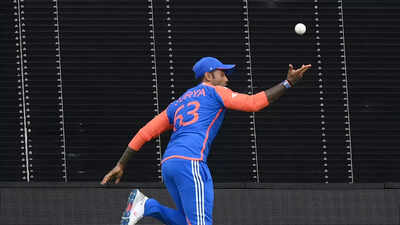The International Cricket Council (ICC) has announced a series of major changes to its playing conditions, impacting Test, ODI, and T20I cricket. The revisions address issues such as over rates, ball usage, boundary catches, concussion protocols, and wide deliveries, all designed to enhance the game.

To tackle the persistent problem of slow over rates, the stop clock rule, previously trialled in shorter formats, will now be permanently implemented in Test matches. The fielding team must commence the next over within 60 seconds of the completion of the previous one. Teams will be issued two warnings per innings, with subsequent violations resulting in a five-run penalty. These warnings will reset every 80 overs, coinciding with the availability of a new ball.
In One Day Internationals (ODIs), the use of two balls will now be restricted to the initial 34 overs. For the remaining 16 overs, the fielding side will have the option to select which of the two balls they wish to continue with. This adjustment aims to facilitate more effective management of ball wear and tear.
The ICC has also clarified the regulations surrounding catches near the boundary. According to the updated rule, fielders making airborne contact with the ball beyond the boundary rope must land completely within the field of play to complete a legal catch. If a fielder steps outside the boundary and jumps again, they are permitted only one additional touch of the ball before landing inside the boundary.
The updated regulations now mandate that teams pre-nominate concussion substitutes. Any player diagnosed with a concussion will be required to observe a mandatory seven-day rest period before being allowed to return to competitive play, prioritizing player safety.
A new wide ball rule is set to be trialled in white-ball formats. The batter's position at the moment the ball is delivered will be the point of reference for judging wides. Deliveries passing between the leg stump and the extended protected area marker at the popping crease will not be called wide. However, deliveries that pass behind the batter's legs may still be considered a wide. To aid umpires in making these judgements, the protected area marker will be extended to the popping crease to serve as a visual guide.
The Decision Review System (DRS) will now incorporate the actual physical outline of the stumps and bails to define the wicket zone, thus improving the accuracy of LBW (leg before wicket) decisions.
In cases of a deliberate short run, in addition to the existing five-run penalty, the fielding team will now have the prerogative to decide which batter will take strike for the subsequent delivery.
In domestic first-class cricket, a player who sustains a serious on-field injury after the match has commenced (including during warm-ups) can be replaced by a like-for-like player for the remainder of the match.
The new Test playing conditions came into effect with the Sri Lanka vs Bangladesh Test match on June 17. The amended ODI and T20I rules will be implemented from the same series, starting with the first ODI on July 2 and the T20Is from July 10. All international matches played after these dates will be subject to the updated regulations.
Newer articles
Older articles
 India Enters New Space Age as Astronaut Shukla Joins ISS Mission
India Enters New Space Age as Astronaut Shukla Joins ISS Mission
 X Cracks Down: Half a Million Indian Accounts Suspended for Policy Breaches
X Cracks Down: Half a Million Indian Accounts Suspended for Policy Breaches
 Google Unveils Strategy to Combat Misinformation, Boost Voter Access in India's 2024 Elections
Google Unveils Strategy to Combat Misinformation, Boost Voter Access in India's 2024 Elections
 Hair Oil vs. Hair Serum: Which is the Right Choice for Your Hair?
Alternatively:
Unlock Your Best Hair: Choosing Between Hair Oil and Serum for a Healthy Mane
Hair Oil vs. Hair Serum: Which is the Right Choice for Your Hair?
Alternatively:
Unlock Your Best Hair: Choosing Between Hair Oil and Serum for a Healthy Mane
 Bollywood's 'Swades' Anthem Joins Axiom-4 Mission: Indian Astronaut's Playlist Honors Heritage in Space
Bollywood's 'Swades' Anthem Joins Axiom-4 Mission: Indian Astronaut's Playlist Honors Heritage in Space
 Vijay Sethupathi Apologizes Amid Controversy Over Son's Film 'Phoenix'
Vijay Sethupathi Apologizes Amid Controversy Over Son's Film 'Phoenix'
 New York Assemblyman Zohran Mamdani's Style: 5 Lessons in Authenticity and Heritage
New York Assemblyman Zohran Mamdani's Style: 5 Lessons in Authenticity and Heritage
 Colon Cancer: Don't Ignore These 5 Early Warning Signs
Colon Cancer: Don't Ignore These 5 Early Warning Signs
 TSMC Regains Top 10 Global Value Ranking Amid AI Boom
TSMC Regains Top 10 Global Value Ranking Amid AI Boom
 Android Users Urged to Update Devices Amid High-Severity Security Flaws: Government Issues Warning
Android Users Urged to Update Devices Amid High-Severity Security Flaws: Government Issues Warning